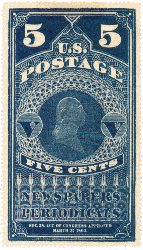

The Counterfeits
I define "counterfeits" as stamps that try to appear as genuine. Many of these stamps, especially the 5¢ value, are excellent!
Most counterfeits are lithographed and hence entirely without embossing. However there are embossed counterfeits. This gets very confusing since some of the regular issues, especially the reprints are very lightly embossed. Telling a counterfeit from an original by whether or not it is embossed is not effective.
Most counterfeits are 11 or 11-1/2. This is an excellent method of checking for a counterfeit although the 11-1/2 perforations get pretty close to a 12 perforation..
Design sizes are usually a good determinant of a counterfeit. Correct design size is approximately 51X95 mm although this may vary as much as a mm. I have counterfeits closer to the right some than some of my real ones.
![]()
![]()
A good test is a very clear "National Bank Note Company" inscription on the bottom of the stamp. Many times this inscription is unreadable or completely missing on the counterfeits. However even this test is sometimes tough if you don't have an original for comparison. The first image above is from an original PR5, the second image is from a very convincing counterfeit.
COUNTERFEIT POSTMARKS
To add insult to injury, many Counterfeit Newspapers were postmarked with a counterfeit postmark. Real postmarks of PR1-8 were daubed on with a brush using thick ink (see The Postmarks). All the nice looking city postmarks on PR1-8 are Counterfeits. "Boston" and "New York" are common since these are American cities easily recognized by the European market.
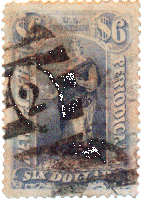
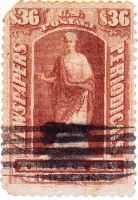
PR9-32s also had fake postmarks applied, usually to cover up the "Facsimile" overprints (sometimes after they had been scraped off). What a coincidence- the cancellation is always where the "Facsimile" overprint would have been!
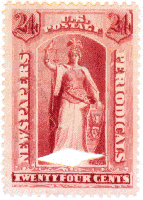
The 24¢, illustrated above appears to be a punch cancel. Again, the punch cancel is exactly where the "Facsimile" overprint should be. This is actually a SENF Facsimile. For more information see The Postmarks
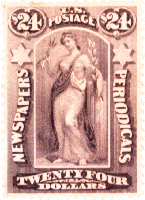
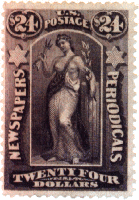
PR29 Proof (Perforated)--- PR 29
PERFORATED PLATE PROOFS
These are very dangerous. A PR29 plate proof has been perforated and passed off as an original. The paper looks right. The clear design of a proof is obviously not a facsimile. Compared to the original on the right, the proof is a little too perfect and doesn't have the depth the original does. As is often the case, when sitting next to an original, counterfeits fool nobody. However in most cases, if you already have an original to compare with, you don't need to buy one. It's best to have these high values expertised.
FAKE COLORS
There seems to be no purpose for these Counterfeits unless they were being passed off as Trial Color Proofs. Even then, most of them don’t match! The best known colors are:
5¢ : Black, Reddish Pink, Green
10¢ : Purple, Lavender, Lemon Yellow, Aquamarine, Red, Silver
25¢ : Bronze, Brown, Green
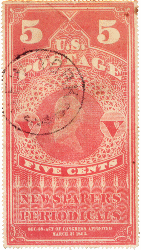
FAKE COLORS WITH FAKE POSTMARKS
Why not?
Reference works available:
United States Newspaper Stamps: 1875-1885- The Facsimiles
This work is a study of the small newspaper stamp facsimiles. With 100 illustrations, it types and illustrates all the small newspaper stamp facsimiles and the forgers who produced them. Invaluable reference work (See the Home Page).
United States Newspaper Stamps: 1865-1869- The Forgeries
With over 100 illustrations, it types all the large newspaper stamp forgeries and explains how to tell them apart from each other and from the regular issues. This is invaluable for the dealer or collector trying to identify the real ones, and for the specialist trying to organize material. (See the Home Page.)